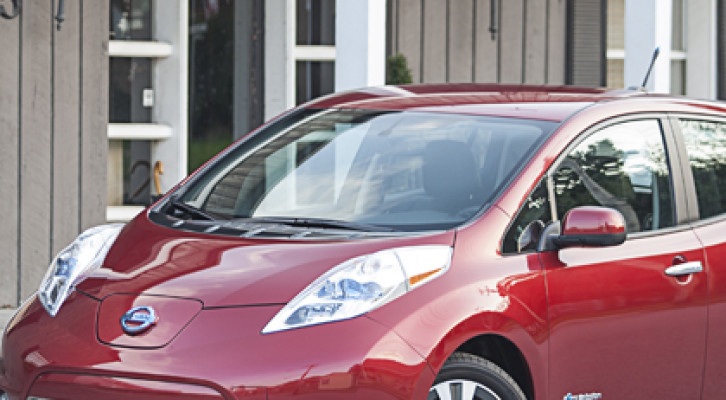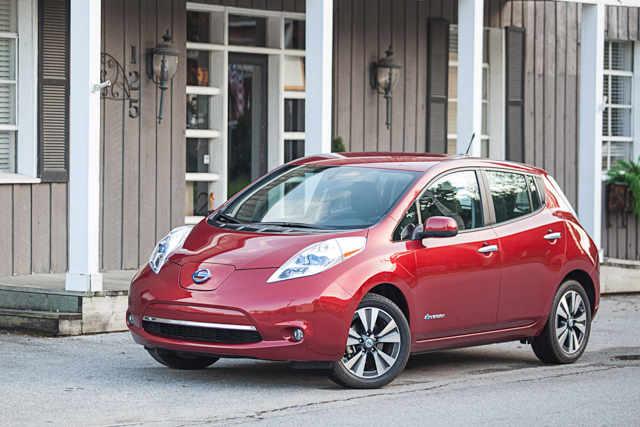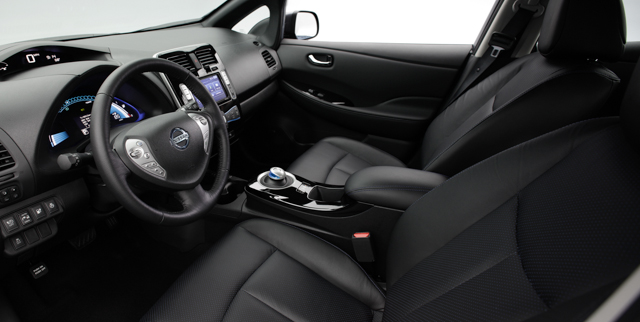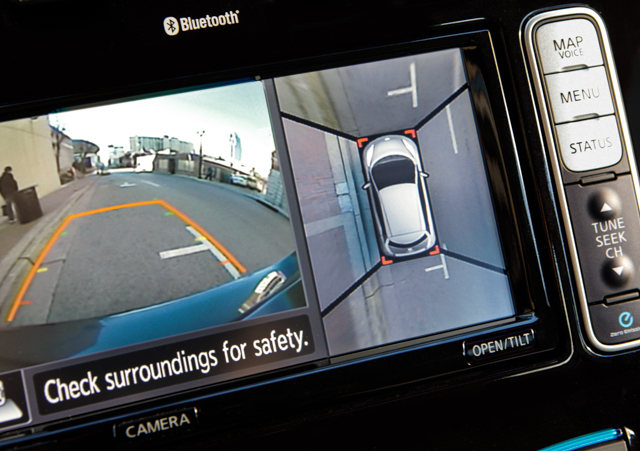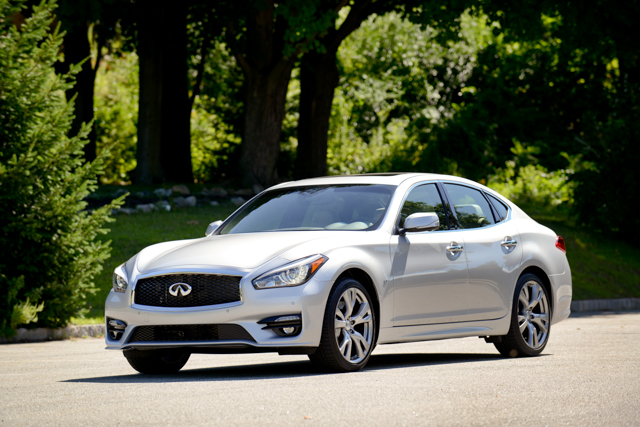Want proof that electric cars are likely to stick around for a while? They’re starting to get normal. Just as the first hybrid Toyotas and Hondas were strange, quirky vehicles that quickly became commonplace, fully electric cars are moving quietly (pun intended) onto the streets of the cities and suburbs, and it’s no longer obvious that you’re looking at one. Take the Nissan LEAF. Entering its fourth year for 2014, the all-electric LEAF is deceptively normal.
The styling is a little unusual, to be sure, but it’s easy to mistake the LEAF for just another subcompact. Unlike the glorified golf carts that started the electric-car revolution, the LEAF is an honest-to-goodness car. It’s got ample space for five passengers, a hatchback with a decent cargo hold, and it has no trouble keeping up with traffic–quite the opposite, in fact.
So what’s the story here? Well, the LEAF looks more or less like any five-door subcompact, with a bit more style than average. The short hood is dominated by big, aeroydynamic headlight units mounted high up and no grille. The large Nissan badge sits proudly on the hatch covering the charging plug, the better to nose the LEAF up to a convenient power post. The one-box design is smooth, maximizing interior space while projecting more personality than the average Prius. The rear sports extravagant hips and crystal LED taillamps that stretch up to the roof, framing the hatchback. It’s a little bulbous from the rear, but very distinctive. Look closely and you’ll see a solar panel in the rear spoiler; it’s used to charge the 12-volt battery and help run the accessories.
The interior is surprisingly spacious, thanks to the lack of intrusion by an exhaust pipe. The battery is mounted under the floor, which enables the LEAF to offer a flat floor and additional passenger room. Behind the rear seat, there’s up to 24 cubic feet of cargo space; Nissan improved this by moving the onboard charger to the front of the vehicle. The rear seats can be folded for an additional six cubic feet as well. The instrument panel is two-tiered, with speed and other vital functions mounted high up in the driver’s field of vision. Everything’s digital, of course, and the console-mounted transmission control feels like a computer piece. Most ancillary controls are accessed through a touch screen on the center stack. The available navigation system has a clever mode that will choose the most energy-efficient route, as well as offering Google Place Search functions to help find restaurants and shops. Heated front and rear seats are standard, and the upholstery contains recycled materials. The heater is a hybrid unit that warms quickly in cold weather without sapping additional power from the battery. The optional seven-speaker Bose audio system uses energy-efficient components. The 360-degree cameras of the Around View monitor and a leather interior are also available.
Nissan has taken full advantage of the instantaneous torque available from an electric motor, and the LEAF is deceptively quick. The 80kW synchronous electric motor produces 107 horsepower. The battery is a 24kWh lithium-ion unit. With all 187 pound-feet of torque on tap from a standstill, the LEAF provides startling acceleration if you floorboard it and keep the pedal there. Actual acceleration times are average for a subcompact, but the rush of power feels like it could be coming from a V8. Normal though it behaves, the LEAF does require some adjustments in driving habits. Thanks to a battery range of about eighty miles, the LEAF is best suited for inner-city urban driving and short-ish hops. Out in the suburbs, where combining errands to save gas has become second-nature, the LEAF’s limited range (compared to a gasoline-powered car) and twelve-hour charging time (at a household outlet) can sometimes be a drawback if a dedicated quick-charge station is not available. A newly optional 6.6 kW onboard
charger reduces charging time to about four hours with a 220V outlet, and a DC charger like those found at public stations will replenish about 80% of the battery’s energy in half an hour. Kept within its comfort zone, the LEAF’s a handy commuter–just keep a mental map of those charging stations.
That’s made easier by Nissan’s CARWINGS telematics system, which connects the LEAF via smartphone to a Nissan information center. CARWINGS allows LEAF drivers to find the closest charging station, as well as providing remote-access functions such as air conditioning precharging and setting of charging times.
With no gasoline engine, the LEAF is silent around town. For pedestrian safety, the car has a speaker up front that makes an alert sound at speeds below 19pmh. This means no more sneaking up on unsuspecting walkers in parking garages.
The suspension is conventional subcompact fare, with MacPherson struts in the front and a torsion-beam rear. The battery’s mounting box is used to add rigidity to the frame as well, so the LEAF feels solid in the curves. Regenerative braking is used to trickle some energy back into the battery during deceleration. The “B” drive mode maximizes regenerative braking.
Apart from the limited range and quiet ride, it’s possible to mistake the LEAF for a gasoline-powered car. That’s in contrast to some electrics, which are clearly different from other vehicles. As an unusually spacious and powerful commuter, the LEAF’s a success. Like most electrics, it comes with a price tag that belies its size though. This may be a compact, but the $28,800 starting price puts it firmly in premium-compact territory. Compared to other electrics, however, the LEAF is reasonable. With Nissan moving production of the LEAF to its Smyrna, TN, facility, there’s a chance that prices will go down over time. A well-equipped LEAF comes in at $35,000 or so.

